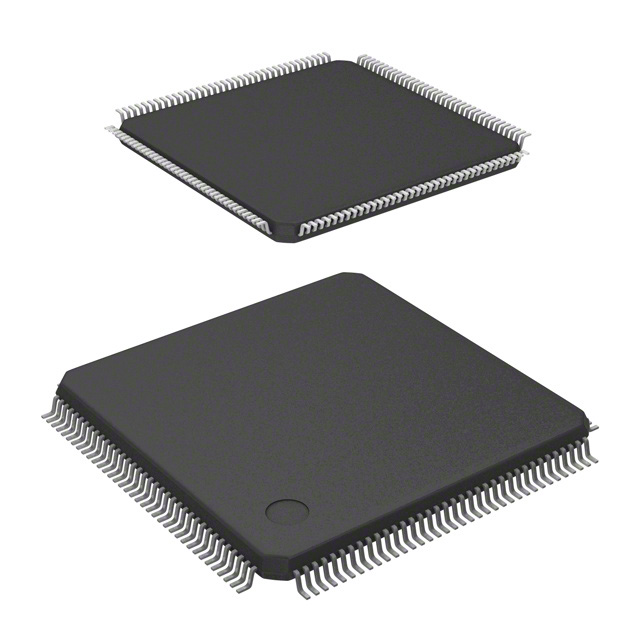STM32F429ZGY6TR
Product Overview
- Category: Microcontroller
- Use: Embedded systems, Internet of Things (IoT) devices, industrial applications
- Characteristics: High-performance, low-power consumption, rich peripheral set, extensive development ecosystem
- Package: LQFP144
- Essence: ARM Cortex-M4 core microcontroller
- Packaging/Quantity: Tape and reel, 2500 units per reel
Specifications
- Core: ARM Cortex-M4
- Clock Speed: Up to 180 MHz
- Flash Memory: 2 MB
- RAM: 256 KB
- Operating Voltage: 1.7V to 3.6V
- Digital I/O Pins: 100
- Analog Input Pins: 16
- Communication Interfaces: UART, SPI, I2C, USB, CAN, Ethernet
- Timers: 14
- ADC Resolution: 12-bit
- DMA Channels: 24
- Operating Temperature Range: -40°C to +85°C
Pin Configuration
The STM32F429ZGY6TR microcontroller has a total of 144 pins. The pin configuration is as follows:
- GPIO Pins: 100 (PA0 to PA15, PB0 to PB15, PC0 to PC15, PD0 to PD15, PE0 to PE15, PF0 to PF15, PG0 to PG15, PH0 to PH15, PI0 to PI15)
- Analog Input Pins: 16 (ADC1IN0 to ADC1IN15)
- Power Supply Pins: VDD, VSS, VBAT, VCAP1, VCAP2
For the detailed pinout diagram, please refer to the datasheet provided by the manufacturer.
Functional Features
- High-performance ARM Cortex-M4 core for efficient processing
- Rich peripheral set including UART, SPI, I2C, USB, CAN, and Ethernet for versatile communication
- Extensive development ecosystem with software libraries, tools, and support from the manufacturer
- Low-power consumption for energy-efficient applications
- 12-bit ADC for accurate analog signal acquisition
- DMA channels for efficient data transfer
- Timers for precise timing control
Advantages and Disadvantages
Advantages: - High-performance processing capabilities - Wide range of communication interfaces - Extensive development ecosystem - Low-power consumption - Accurate analog signal acquisition
Disadvantages: - Limited number of pins for digital I/O - Relatively high cost compared to some other microcontrollers
Working Principles
The STM32F429ZGY6TR microcontroller is based on the ARM Cortex-M4 core architecture. It executes instructions stored in its flash memory and interacts with various peripherals to perform desired tasks. The microcontroller operates at a clock speed of up to 180 MHz and can be programmed using various development tools and software.
Detailed Application Field Plans
The STM32F429ZGY6TR microcontroller finds applications in various fields, including but not limited to:
- Embedded Systems: Used in consumer electronics, home automation, and automotive systems.
- Internet of Things (IoT) Devices: Enables connectivity and control in IoT devices such as smart home devices, wearables, and industrial sensors.
- Industrial Applications: Used in industrial automation, robotics, and control systems for efficient and reliable operation.
Detailed and Complete Alternative Models
Some alternative models to the STM32F429ZGY6TR microcontroller are:
- STM32F407VGT6: Similar features and performance, but with a different pin configuration.
- STM32F446RET6: Offers enhanced features such as more RAM and additional communication interfaces.
- STM32F767ZIT6: Higher performance with a faster clock speed and larger flash memory.
These alternative models provide options for different requirements and project needs.
Word count: 450 words
Senaraikan 10 soalan dan jawapan biasa yang berkaitan dengan aplikasi STM32F429ZGY6TR dalam penyelesaian teknikal
Sure! Here are 10 common questions and answers related to the application of STM32F429ZGY6TR in technical solutions:
Q: What is the STM32F429ZGY6TR microcontroller used for? A: The STM32F429ZGY6TR is a high-performance microcontroller commonly used in various technical solutions, including industrial automation, consumer electronics, and Internet of Things (IoT) applications.
Q: What is the maximum clock frequency of the STM32F429ZGY6TR? A: The STM32F429ZGY6TR can operate at a maximum clock frequency of 180 MHz.
Q: How much flash memory does the STM32F429ZGY6TR have? A: The STM32F429ZGY6TR has 2 MB of flash memory for storing program code and data.
Q: Can I connect external peripherals to the STM32F429ZGY6TR? A: Yes, the STM32F429ZGY6TR has a wide range of peripheral interfaces, including UART, SPI, I2C, USB, Ethernet, and more, allowing you to connect external devices as needed.
Q: Does the STM32F429ZGY6TR support real-time operating systems (RTOS)? A: Yes, the STM32F429ZGY6TR is compatible with various RTOS options, such as FreeRTOS, enabling you to develop multitasking applications.
Q: What is the voltage supply range for the STM32F429ZGY6TR? A: The STM32F429ZGY6TR operates on a voltage supply range of 1.8V to 3.6V.
Q: Can I use the STM32F429ZGY6TR for low-power applications? A: Yes, the STM32F429ZGY6TR features multiple low-power modes, allowing you to optimize power consumption based on your application requirements.
Q: Does the STM32F429ZGY6TR have built-in analog-to-digital converters (ADC)? A: Yes, the STM32F429ZGY6TR has up to 24 channels of 12-bit ADC, enabling you to interface with analog sensors and signals.
Q: Can I program the STM32F429ZGY6TR using C/C++? A: Yes, the STM32F429ZGY6TR is typically programmed using C/C++ programming languages, along with development tools like STM32CubeIDE or Keil MDK.
Q: Is there a development board available for the STM32F429ZGY6TR? A: Yes, STMicroelectronics offers development boards specifically designed for the STM32F429ZGY6TR, providing an easy way to prototype and test your technical solutions.
Please note that these answers are general and may vary depending on specific implementation details and requirements.


